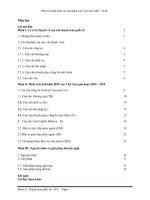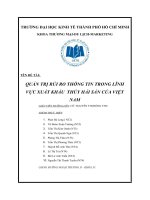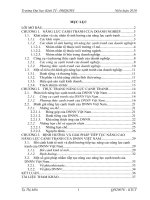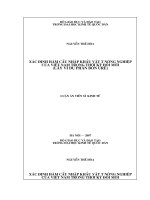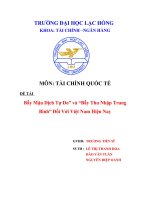Bẫy thu nhập trung bình ở Malaysia và thực tiễn của Việt Nam (Middle income trap in Malaysia and lessons for Vietnam)
Bạn đang xem bản rút gọn của tài liệu. Xem và tải ngay bản đầy đủ của tài liệu tại đây (1.7 MB, 85 trang )
FOREIGN TRADE UNIVERSITY
FACULTY OF INTERNATIONAL ECONOMICS
---------***--------
GRADUATION THESIS
HOW MALAYSIA CAN BREAK THROUGH THE
‘MIDDLE-INCOME TRAP’ AND LESSONS FOR
VIETNAM
Full name
: Dang Thi Huyen
Student ID : 1311450020
Class
: English 7 – High Quality Program
Cohort
: 52
Supervisor : Assoc.Prof.Dr Vu Hoang Nam
Hanoi, June 2017
i
TABLE OF CONTENTS
LIST OF ABBREVIATIONS ......................................................................................iii
LIST OF TABLES ........................................................................................................ iv
LIST OF FIGURES ....................................................................................................... v
INTRODUCTION .......................................................................................................... 1
CHAPTER I.................................................................................................................... 4
THEORETICAL BACKGROUND ABOUT MIDDLE-INCOME TRAP .............. 4
1.1
Concepts of Middle-Income Trap ...................................................................... 4
1.1.1
Concept of Middle-Income .......................................................................... 4
1.1.2
Concept of the Middle-Income Trap ........................................................... 5
1.2
Criteria to be defined as having fallen into the Middle-income Trap .............. 10
1.2.1
Determining the number of years to be in the Trap ................................... 10
1.2.2
Countries in the Trap ................................................................................. 12
1.3
Causes for falling into a Middle-Income Trap ................................................. 14
1.3.1
Exhaustion of cheap labor ......................................................................... 15
1.3.2
Changes in economic structure .................................................................. 17
1.3.3
Low quality of labor .................................................................................. 18
1.3.4
Growing income inequality ....................................................................... 19
1.3.5
Poor institutional quality ........................................................................... 20
1.3.6
Population ageing ...................................................................................... 21
CHAPTER II ................................................................................................................ 22
MALAYSIA AND THE MIDDLE-INCOME TRAP ............................................... 22
2.1
Overview of Malaysia’s economy since getting Middle-Income level ........... 22
2.1.1
Income per capita and economic growth ................................................... 23
2.1.2
The economic structural change. ............................................................... 25
2.1.3
The quality of labor ................................................................................... 27
2.1.4
The income inequality ............................................................................... 29
2.1.5
Political system reform .............................................................................. 31
2.1.6
Population age distributions ...................................................................... 32
ii
2.2
Causes of falling into the Middle-Income Trap in Malaysia ........................... 35
2.2.1
The inconsistent New Economic Policy framework (1970-2009) ............ 36
2.2.2
Low human capital quality ........................................................................ 39
2.2.3
An investment rate slump due to currency crisis ....................................... 41
2.3
Malaysia towards becoming a high-income nation by Economic
Transformation Programme (ETP) ............................................................................. 44
2.3.1
Overview of ETP ....................................................................................... 44
2.3.2
Achievements of Malaysian economy since the launch of ETP ............... 50
CHAPTER III .............................................................................................................. 57
STATUS QUO AND RECOMMENDATIONS FOR VIETNAM AVOIDING THE
TRAP ............................................................................................................................. 57
3.1
Status quo of Vietnam’s economy since achieving Middle-Income level ....... 57
3.1.1
Situation of Vietnamese economy since achieving the Middle-income....58
3.1.2
Vietnam faces challenges in falling into the Middle-Income Trap ........... 63
3.2
Recommendations for Vietnam avoiding Middle-income trap based on
experiences of Malaysia ............................................................................................. 70
3.2.1
Recommendation for human resources ..................................................... 70
3.2.2
Recommendation for population ageing.................................................... 72
3.2.3
Recommendation for reducing income inequality .................................... 73
CONCLUSION............................................................................................................. 76
REFERENCES ............................................................................................................. 77
iii
LIST OF ABBREVIATIONS
No.
Abbreviations
Full name
1
GDP
Gross Domestic Product
2
WTO
World Trade Organization
3
MICs
Middle-income countries
4
L
Low-income
5
LM
Lower-middle income
6
UM
Upper-middle income
7
H
High income
8
GNI
Gross National Income
9
US
United States
10
MIT
Middle-Income Trap
11
ICTs
Information and communication technologies
12
NEP
New Economic Policy
13
ETP
Economic Transformation Programme
14
TI
Transparency International
15
TFP
Total Factor Productivity
iv
LIST OF TABLES
Table 1. 1: GNI per capita US (Atlas Method) ............................................................... 4
Table 1. 2: Economies in the lower-middle-income trap in 2016 ................................. 13
Table 1. 3: Economies in the upper-middle-income trap in 2016 ................................. 12
Table 2. 1: Classification of Malaysia’s income threshold in each period ................... 22
Table 2. 2: Sectorial Share of GDP ............................................................................... 25
Table 2. 3: Share of employment as %GDP ................................................................. 26
Table 2. 4: Expenditure as percent of GDP................................................................... 28
Table 2. 5: Enrollment by educational level, 1975-2015 .............................................. 28
Table 2. 6: Gini coefficient by Ethnic group, 1971-2014 ............................................. 30
Table 2. 7: Fertility rate, Life expectation and mortality in Malaysia .......................... 33
Table 2. 8: Average rates of increase in labor productivity .......................................... 42
Table 2. 9: NKEAs- KPI scorecard, 2012-2015 ........................................................... 51
Table 2. 10: SRI – KPI scorecard, 2013-2015 .............................................................. 52
Table 2. 11: Comparing NKEA targets and actual jobs created (2010-2015) .............. 53
Table 3. 1: Vietnam’s ICOR, 2000-2010 ...................................................................... 64
Table 3. 2: Some factors about income distribution and inequality in Vietnam........... 66
Table 3. 3: Income per capita on average in urban and rural areas............................... 66
Table 3. 4: "gold" population structure period in Vietnam ........................................... 68
v
LIST OF FIGURES
Figure 1. 1: Development stages of an economy ............................................................ 6
Figure 1. 2: Stages of the catching up process in Ohno’s MIT model ........................... 8
Figure 1. 3: Aoki's five phases ........................................................................................ 9
Figure 1. 4: Becoming stuck in the Middle-Income Trap ............................................ 16
Figure 2. 1: Malaysia’s growth rate from 1971 to 2015 (%) ........................................ 24
Figure 2. 2: Malaysian Population per Age Group 2014 .............................................. 34
Figure 2. 3: Malaysia corruption rank, 1996-2016 ....................................................... 37
Figure 2. 4: Control of corruption in Malaysia, 1996-2015.......................................... 38
Figure 2. 5: Trends in Math (left) and Science (right) from 1999–2015 ...................... 40
Figure 2. 6: The investment rate in Malaysia ............................................................... 42
Figure 2. 7: Fixed capital formation/GDP .................................................................... 43
Figure 2. 8: Determinants of ETP ................................................................................. 45
Figure 2. 9: The national key economic areas (NKEAs) .............................................. 46
Figure 2. 10: Six strategic reform initiatives (SRIs) ..................................................... 48
Figure 2. 11: Traffic Lights of methods 1 and 2 ........................................................... 49
Figure 2. 12: Traffic Lights of methods 3 ..................................................................... 49
Figure 2. 13: Employment by sector ............................................................................. 53
Figure 2. 14: Investment accelerated post-ETP ............................................................ 54
Figure 2. 15: GNI per capita continues to growth from 2009-2015 ............................. 55
Figure 3. 1: The ETP Scorecard KPIs ........................................................................... 50
Figure 3. 2: GNI per capita in Vietnam, 2008-2015 ..................................................... 58
Figure 3. 3: Vietnam GDP’s growth rate from 2008 to 2015 ....................................... 59
Figure 3. 4: Structural change ....................................................................................... 60
Figure 3. 5: Dynamic economic structure 2008-2015 .................................................. 61
Figure 3. 6: Percentage of trained employed workers at 15 years of age and above by
qualification by Qualification and Year ......................................................................... 62
vi
Figure 3. 7: 2016 A.T Kearney global services location index ................................... 69
1
INTRODUCTION
1. Rationale of the study
After the Asian financial crisis (AFC) of 1997-98, a large number of countries
found themselves able to escape their low-income position and start climbing the higher
income thresholds. Many of those thought that they took for a long period of sustained
growth in order to catch up with the high-income countries. However, most of these
countries were found being stuck in a “middle-income trap” (MIT) phenomenon, like
Malaysia.
In 1971, Malaysia became the lower-middle income country with Gross Domestic
Product (GDP) per capita at $2.036,859 which was calculated by the World Bank. From
then on, Malaysia experienced a high growth performance and reached to upper-middle
income level in 1996. However, Malaysia’s robust growth over the last three decades
was interrupted following the Asian financial crisis (AFC) in the period of 1997-98.
Since then, Malaysian growth has been relatively volatile and unable to make the leap to
advanced income status. In addition to the AFC, some of the factors that also prevent or
delay the shift to high-income status include a larger risk of a growth slowdown,
insufficient human capital, or the impact of New Economic Policy from 1970 to 2009.
By 2010, the country had taken to well over than 14 years to participate as upper-middle
income country and become stuck in the “upper-middle income trap”, based on Felipe
(2012a)’s method that a country is in the Middle-Income Trap if it has been in lowermiddle-income category more than 28 years and if it has been in an upper middle-income
category more than 14 years. Up to now, Malaysia has been in the upper-middle income
nearly 22 years and still trying to break through the upper-middle income trap, advancing
into the high-income phase of development
In such context, crucial questions remain whether Malaysia can reach high-income
status and which policies it needs to implement to succeed. This is why, the author would
like to analyze the problems that this country are facing and bring Malaysian economy
out of the middle-income trap, so as to recommend appropriate strategies to Vietnam
2
avoiding Middle-income trap because Vietnam is since 2008 in the lower-middle income
level, so it is more than 18 years to prepare against the lower-middle income trap
To conclude, realizing the essence of the topic and also positive outcome that
might be produced during developing the Vietnam economy with purpose of overcoming
“Middle-income trap” as the Malaysian has been doing implemented, the topic “How
Malaysia can break through Middle-Income Trap and lessons for Vietnam” has been
chosen for my graduation thesis at Hanoi Foreign Trade University.
2. Objectives of the study
The study attempts to determine the causes of falling into the Middle-income trap
of Malaysia and how that country can break through the Trap. From those dimensions,
the author would analyze this problem in Vietnam and give some implications on
policies to promote the Vietnam’s growth and recommend feasible suggestions for
Vietnam to avoid Middle-income trap.
3. Scope of the study
Within the framework of a graduation thesis, the author would like to focus on
analyzing economic development, outstanding issues and limitations in Malaysia and
Vietnam’s economies since getting the Middle-Income level.
In addition, the thesis also focus on analyzing an idea given by the Malaysian
government to turn Malaysia into a high-income economy by the year of 2020, that is
titled “Economic Transformation Programme”
4. Research methodologies
In order to investigate in the Trap, the theoretical systems of Middle-Income,
especially the theory and regulations of World Bank or famous authors, have been used
as the basis of the thesis. Moreover, the readers will find various sets of data to be quoted
and combined in the content; those may come from the statistical data or reports of
organizations like UN COMTRADE, World Bank. Using that data helps to make a
critical comparison, draw logical conclusion and get lessons learned from Malaysia.
Additionally, other methods such as inductive method, qualitative method and
theoretical method will also be used.
3
5. Structure of the thesis
Apart from introduction, conclusion, references and appendices, the thesis comprises the
following sections as main elements
Chapter 1: Concepts of Middle-Income Trap
Chapter 2: Malaysia and the Middle-income Trap
Chapter 3: Status quo and recommendations for Vietnam avoiding the Trap
6. Acknowledge
The author would like to express deep gratitude to Assoc.Prof.Dr Vu Hoang Nam,
Ph.D. Associate Professor of Foreign Trade University for his critical comments and
encouraging support as a supervisor. He has employed his strong research expertise and
experience not only to orient the topic, structure the outline but also to have overall and
detailed looks into the study to help the author accomplish it in a better way.
Being aware of the importance of the thesis, the author has paid serious attention
to study and research. However, due to limited time, reference resources and professional
competences as well as practical experience, the thesis does expose a number of
shortcomings. Thus, any feedback or comment for this study would be of great value for
the author to improve it later on.
4
CHAPTER I
THEORETICAL BACKGROUND ABOUT MIDDLE
INCOME TRAP
1.1 Concepts of Middle-Income Trap
1.1.1 Concept of Middle-Income
According to World Bank’s classifications, countries in the world are divided into
four income levels that are low-income (L), lower-middle income (LM), upper-middle
income (UM), and high-income (H), on the basis of per capita gross national income
(GNI). The reason why World Bank chose GNI as criteria in order to determine these
level is that GNI was ‘the best single indicator of economic growth and progress’, that
showed ‘a stable relationship between a summary measure of well-being such as poverty
incidence and infant mortality on the one hand and economic variables including per
capita GNI’1.
The classification baseline is altered one time per year. It is made public on July 1
of every year based on the per capita GNI from the previous year and is not changed for
the duration of the year. It is based on nominal exchange rate, and so it is revised annually
so that real value does not change.
Table 1. 1 GNI per capita US (Atlas Method)
Unit: millions of US dollars
Date
1-Jul-2011
1-Jul-2012
1-Jul-2013
1-Jul-2014
1-Jul-2015
1-Jul-2016
2010
2011
2012
2013
2014
2015
L
≤ 1.005
≤ 1.025
≤ 1.035
≤ 1.045
≤ 1.045
≤ 1.025
LM
≤ 3.975
≤ 4.035
≤ 4.085
≤ 4.125
≤ 4.125
≤ 4.035
UM
≤ 12.275
≤ 12.475
≤ 12.615
≤ 12.745
≤ 12.735
≤ 12.475
H
> 12.275
> 12.475
> 12.615
> 12.745
> 12.735
> 12.475
Source: World Development Indicators (updated in 2017)
1
World Bank classification
5
From the table, we can see that the latest income classification of the World Bank
defines low-income countries as those with GNI per capita of $1.025 or less in 2015,
lower-middle income if its GNI per capita lies between $1.026 and $4.035, upper-middle
income if its GNI per capita lies between $4.036 and $12.475, and high-income if its
GNI per capita is $12.475 or above.
Under this classification, it is clearly to see that middle-income is further divided
into lower-middle and upper-middle income with a per capita GNI for at least $1.026
and less than $12.475.
1.1.2 Concept of the Middle-Income Trap
The term “middle-income trap” (MIT) first appeared in the World Bank’s An East
Asian Renaissance: Ideas for Economic Growth, which stated that “middle-income
countries…have grown less rapidly than either rich or poor countries” (Gill and Kharas,
2007).
Nowadays, the term “Middle-Income Trap” is being widely used and discussed
among researchers and policymakers. Especially, the number of papers mentioning this
supposedly observable phenomenon, as well as indirect references to it, has increased
significantly. For instance, in April 2016, there are 231 total search results in
EBSCOhost4 and 52 in the Web of Science (Core Collection, by Thomas Reuters, 2016)
There are huge researches as well as many different ideas about what MIT is. Thus,
it is desirable to have a clear and precise definition of MIT. From that, I chose three
different perspectives that are the most common explanation in order to have a clear see
about this phenomenon.
The first elementary explanation approach of Trap is based on growth slowdowns
theory by the Dual-sector model developed by W. Arthur Lewis (1954), also known as
the “Lewis model”. The second explanation approach is given by Ohno (2009) with
different development stage that an economy has to pass on the way to the stage of a
developed, high-income country. Finally, another phase concept is developed by Aoki
(2011). It is quite similar to Ohno’s approach but focuses on China, Korea, and Japan.
6
1.1.2.1Lewis model (1954)
Lewis (1954) introduced a dual economy model in order to describe this
development process. His dual economy consists of a ‘traditional’ and a ‘modern’ sector.
The distinction between these two sectors is mostly based on the distinction
“agricultural” and “industrial”
Figure 1. 1 Development stages of an economy
⃗⃗⃗⃗⃗
𝐴𝐵 : Traditional society, underdeveloped and facing “poverty trap”
⃗⃗⃗⃗⃗
𝐵𝐶 : Start of the development stage, escape from “poverty trap”
C: Middle-income level
⃗⃗⃗⃗⃗
𝐶𝐷 : Sustained growth towards the high-income level
D: High-income level
⃗⃗⃗⃗⃗ : Stagnation – “middle-income trap”
𝐶𝐸
A country starts as a traditional society, being underdeveloped and facing the
poverty trap ( ⃗⃗⃗⃗⃗
𝐴𝐵 ). Once this country is able to escape the poverty trap, it can start its
development of markets
⃗⃗⃗⃗⃗ ), a country faces a structural
In this second stage of development (𝐵𝐶
transformation with a shift from agricultural production towards industrial production.
The initial surplus of labor in the ‘traditional’ sector provides the modern sector with
7
low-cost labor keeping the costs of industrial production low. The country is able to
compete in international markets producing labor-intensive, low-cost products.
Over time, the surplus of labor in the agricultural sector is absorbed by the
industrial sector till the point where the surplus disappears. In order to keep attracting
labor, the modern sector has to raise wages, thereby eroding competitiveness. We arrive
at the “Lewis turning point” (point C).
At this point, it is important for the country to generate the right circumstances in
order to be able to pass fluently on to the next stage of sustained growth towards being
a high-income country ( ⃗⃗⃗⃗⃗
𝐶𝐷 )
A country that fails to create these circumstances will get squeezed between low
wage poor country competitors and rich country innovators and will be trapped as a
middle-income country with low growth rates as the line from C to E – “the middleincome trap”
1.1.2.2Kenichi Ohno (2009)
Ohno (2009) primarily considers the ASEAN countries (Association of Southeast
Asian Nations) to complete this model. According to the basic structure is displayed in
figure 1.2, the Middle-Income Trap is defined as the “glass ceiling” between the second
and third stages. The transition from stage two to stage three is separated by an “invisible
glass ceiling” a country has to break through if it wants to reach high-income status.
According to the Kenichi Ohno’s perspective, economic take-off starts with the
arrival of a sufficient mass of manufacturing Foreign Direct Investment (FDI) firms that
perform simple assembly or processing of light industry products for export.
In this early stage (stage one), design, technology, production, and marketing are
all directed by foreigners, key materials and parts are imported, and the country
contributes only unskilled labor and industrial land. While this generates jobs and
income for the poor, internal value remains small and value created by foreigners
dominates. Vietnam’s industrialization up to now has been basically characterized by
this situation.
8
Figure 1. 2 Stages of the catching up process in Ohno’s MIT model
Source: Kenichi Ohno (2009), the Middle-Income Trap
In the second stage, as FDI accumulates and production expands, the domestic
supply of parts and components begins to increase. This is realized partly by the inflow
of FDI suppliers and partly by the emergence of local suppliers. As this occurs, assembly
firms become more competitive and a virtuous circle between assemblers and suppliers
sets in. The industry grows quantitatively through the internal supply of physical inputs.
Internal value creation rises moderately, but production basically remains under foreign
management and guidance. Thailand and Malaysia have already reached this stage.
The next challenge is to internalize skill and knowledge by accumulating industrial
human capital. Locals must replace foreigners in all areas of production including
management, technology, design, factory operation, logistics, quality control, and
marketing. As foreign dependence is reduced, the internal value rises dramatically. The
country emerges as a dynamic exporter of high quality manufactured products
challenging more advanced competitors. Korea and Taiwan are such producers.
In the final stage, the country acquires the capability to create new products and
lead global market trends. Japan, the United States, and some members of the European
Union are such industrial innovators.
9
However, progress is not guaranteed for all. A large number of countries that
receive too little manufacturing FDI stay at stage zero. Even after reaching the first stage,
climbing up the ladders becomes increasingly difficult. Another group of countries is
stuck in the second stage because they fail to upgrade human capital. It is noteworthy
that none of the ASEAN countries, including Thailand and Malaysia, has succeeded in
breaking through the invisible “glass ceiling” in manufacturing between the second and
the third stage. A majority of Latin American countries remain middle income even
though they had achieved relatively high income as early as in the nineteenth century.
This phenomenon can be collectively called the middle-income trap.
1.1.2.3Aoki (2011)
Figure 1. 3 Aoki's five phases
• agricultural employment > 80%
M-phase • low and stationary per capita income
G-phase
• industrialization
• moderate structural change
• moderate growth of per capita income
K-phase
• high growth of per capita income
• fast structural change
• "demographic gift"
H-phase
• sustainable growth of per capita income
• demographic change
PD-phase
• growth is dependent on the occurrence of technological, socioeconomic,
and demographic changes
Source: Aoki (2011)
10
It is quite similar to Ohno’s approach but focuses on China, Korea, and Japan. Aoki
(2011) also divides the development process into five phases, namely the Malthusian
(M), the government-led (G), the Kuznets (K), the human capital based (H), and the postdemographic-transition (PD) phase, which according to him - apply to all three countries.
According to Aoki (2011), a country becomes caught in the MIT if it does not succeed
in completing the transition from the K- to the H-phase.
Also, Aoki (2011) starts in his first M-phase with the Malthusian model. Aoki
(2011), however, adds between the M-phase and the K-phase, which describes the dual
economy, a G-phase, which takes into account the actions of the government. After the
Lewis turning point has been reached and the K-phase ends, it takes by Aoki (2011), an
H-Phase, which is based on human capital in order to achieve the high-income level. The
last phase, the PD-phase is then the last phase before the high-income level.
1.2 Criteria to be defined as having fallen into the Middle-income Trap
1.2.1 Determining the number of years to be in the Trap
To determine the duration that a country has to be in the Middle-Income group, it
is calculated by examining the historical experience of the countries that graduated from
lower- to upper-middle income and from the latter to high-income, thereby leading to
take the answers that how many years a country was in the two Middle-Income group.
By this way, we can easily identify which middle-income country is trapped in the
middle-income trap and which is not.
As the benchmark classifications of the World Bank listed in part 1.1.1, World
Bank classifies countries based on their Gross National Income (GNI) per capita as four
groups: low income, lower-middle income, upper-middle income and high income.
However, these classifications were from 1987 onward. This is too short a time
series in order to use this classification for identifying countries in the MIT, as many
economies were already high income in 1987. Moreover, some other economies were
upper-middle income in 1987 and made it into the high-income group afterward.
Determining income threshold an economy has to be in the middle-income trap before it
11
can be considered that its transition is slow requires time-series data longer than those
provided by the World Bank.
Therefore, Felipe (2012a) proposed a method to adapt the classification coming
from the World Bank to the dataset from Maddison. He extended this database for the
countries that needed up to 2010 using growth rates for GDP per capita measured in
constant prices from the World Economic Outlook database (International Monetary
Fund, 2013) and restricted the data to 100 countries for which have now a balanced
dataset for the years 1950–2010.
This set thresholds is defined as follows: 𝑡1 = $2000, 𝑡2 = $7.250, 𝑡3 = $11.750
𝑡1 = $2000
Separating low from lower-middle income
𝑡2 = $7.250
Separating lower-middle from upper-middle income
𝑡3 = $11.750
Separating upper-middle from high income
These thresholds are constant over time
From that thresholds, Felipe et. al. found that a median number of years for a lower
middle-income country to join the upper middle-income group is 28 years and for an
upper middle-income country, it takes 14 years to become a member of the high-income
group. This implied that if a country is in the Middle-Income Trap if it has been in a
lower-middle-income category more than 28 years and if it has been in an upper middleincome category more than 14 years.
Given this thresholds, it is a possibility to calculate that a lower middle-income
country needs to grow at least 4,15% per year over 28 years in order not to get trapped.
An upper middle-income country will need to sustain a minimum growth rate of 3,95%
over 14 years before being defined as trapped.
12
1.2.2 Countries in the Trap
The middle-income trap can be divided into a lower middle-income trap and
upper middle-income trap. The extension the database of Maddison for the years from
1950 to 2016 instead of 1950-2010 to have the result of countries in the trap. Thus, the
result is that 28 countries fall into the middle-income trap, 23 of them are in the lower
middle-income trap and the remaining five are in the upper middle-income trap. The
majority of the middle-income trap countries are from the Latin America constituting 11
countries out of 28 countries in the region.
Table 1.2 and Table 1.3 below list out the detailed information of which countries
were in the lower middle-income trap and upper middle-income trap, based on the
criteria given above.
Table 1. 2 Economies in the upper-middle-income trap in 2016
Unit: Current Dollars
Country
Region
2015 GDP per
No.of years
No. years as UM
capita
as LM
until 2016
Malaysia
Asia
10.878
27
21
Uruguay
Latin America
10.934
112
15
Venezuela
Latin America
9.662
23
60
Syria
Middle East
8.717
46
15
Saudi Arabia Middle East
8.396
20
32
Source: Abdon, Felipe, and Kumar
13
Table 1. 3 Economies in the lower-middle income trap in 2016
Unit: Current Dollars
Country
Region
2015 GDP per capita
No. years as LM
until 2016
Philippines
Asia
2.639
40
Sri Lanka
Asia
3.637
34
Albania
Europe
4.543
43
Bolivia
Latin America
2.392
51
Dominican, Rep.
Latin America
6.552
44
Ecuador
Latin America
5.366
64
El Salvador
Latin America
3.853
53
Brazil
Latin America
6.542
58
Guatemala
Latin America
3.052
66
Jamaica
Latin America
4.880
62
Paraguay
Latin America
3.822
44
Peru
Latin America
5.934
67
Algeria
Middle East
4.784
48
Egypt
Middle East
2.707
37
Iran
Middle East
5.936
58
Jordan
Middle East
3.976
61
Lebanon
Middle East
7.045
64
Morocco
Middle East
3.239
40
Tunisia
Middle East
4.272
45
Yemen, Rep.
Middle East
774
41
Botswana
Sub-Saharan Africa
7.080
34
Congo, Rep.
Sub-Saharan Africa
3.163
39
Namibia
Sub-Saharan Africa
6.000
67
Source: Abdon, Felipe, and Kumar
14
To summarize, 28 out of the 52 middle-income countries today are in the middleincome trap, 23 countries in the lower-middle-income trap and 5 countries in the uppermiddle-income trap. 11 of those in the trap are in Latin America, 10 are in the Middle
East and North Africa, 3 in Sub-Saharan Africa, 3 in Asia, and 1 in Europe. The transition
through the middle-income may not be a trap in the same sense it is used to describe the
problem of the poor low-income countries, but it can be a long walk for many countries.
1.3 Causes for falling into a Middle-Income Trap
Becoming a high-income country is not an easy walk. The transition from lowermiddle income into upper-middle income, and then into high-income, can be a slow
process. Some countries have been stuck in the long middle-income trap for decades.
Others are passing through it now and hoping to become high-income as quickly as
possible. Various explanations have been put forward to explain the existence of middleincome traps.
As Eichengreen et al. (2011), he emphasizes that high growth rates in earlier
periods, unfavorable demographics, very high investment rates, and undervalued
exchange rates support a growth slowdown, and hence the probability of getting stuck in
an MIT.
Jimenez et al. (2012) and Jitsuchon (2012) also underline the importance of human
capital accumulation and quality of education. They add that growth slowdowns occur
less frequently in economies where a relatively large share of the population have higher
secondary and tertiary education.
Felipe et al. (2012) state that the knowledge and skill capabilities of the labor force
in these countries are critically low to produce and export the high-tech commodities.
Similarly, Jankowska et al. (2012) list important reasons of the trap. These reasons are
low productivity of labor and lack of structural labor transformation, respectively.
Aiyar et al. (2013), who emphasize the importance of institutional, demographic,
and infrastructural factors, as well as trade structure, present their empirical results in a
very detailed, country-specific way. They develop a “trap map” for Asian, Latin
American, and MENA middle-income countries. The trap map shows which of the seven
15
identified
factors
(Institutions,
Demography,
Communication,
Road,
Output
Composition, Macroeconomic Factors, and Trade) presents a particular growth
slowdown risk for a country compared to the other countries.
Eichengreen et al. (2013) associate middle-income trap with some demographic
and economic factors. Aging of the population, unproductive investment decisions and
undervalued exchange rates which prevent technological progress.
Kanchoochat (2014) and Kanchoochat and Intarakumnerd (2014) poor quality of
education and institutional structure are important reasons of the middle-income trap.
According to the descriptive analysis by Bulman et al. (2014), countries that
managed to escape the middle-income range experienced higher Total Factor
Productivity (TFP) growth, low inflation, as well as a relatively rapid structural
transformation process (from agriculture to industry) compared to the countries that were
not able to make a successful transition to the high-income range
Clearly, we can see that there must be a multiplicity of reasons given by economist,
preventing a country which cannot graduate from lower-middle income into uppermiddle income and from the latter into high income. Instead of trying to identify all the
possible reasons that may underlie failure of transitions, I chose some factors that most
had mentioned many times in listed studies as labor aspect (Kaldor, 1967; Chenery and
Taylor, 1968); income inequality (Flechtner und Panther, 2015); institutions (Aiyar et
al., 2013; Kanchoochat and Intarakumnerd, 2014) and age-structured population (Aiyar,
2013); Eichengreen et al., 2011; Eichengreen et al., 2013). These factors will also support
for my thesis in the following chapter.
1.3.1 Exhaustion of cheap labor
According to Lewis-type (1954) development process as noted earlier, factors and
advantages that generate high growth during an initial phase of rapid development - low
cost labor and imitation of foreign technology- disappear when middle- and uppermiddle income levels are reached, thereby requiring new sources of growth to maintain
sustained increases in per capita income. This process is displayed in figure 1.4
16
Figure 1. 4 Becoming stuck in the Middle-Income Trap
As economies moves from low- to middleincome status, they can compete internationally
by moving from agricultural to labor intensive,
low-cost manufactured products
Using imported technologies, late-developing
economies reap productivity gains as workers
shift from the agricultural sector to the
manufacturing sector
The pool of transferrable unskilled labor is
exhausted, or the expansion of labor-absorbing
activities peaks.
As countries reach middle-income levels, real
wages in urban manufacturing rise or market
share is lost, and gains from importing foreign
technology diminish
Productivity growth from sectorial reallocation
and technology catch-up are eventually exhausted,
international competitiveness is eroded, output
and growth slow, and economies become trapped
Source: Author’s illustration
Indeed, during the initial phase of development, low-income countries can compete
in global markets by producing labor-intensive, low-cost products using technologies
imported from developed countries (Agenor and Dinh, 2012). Subsequently, these
countries can achieve large productivity gain through a reallocation of labor from the
low productivity agricultural sectors to high-productivity manufacturing sectors.
However, once these countries reach middle-income levels, the pool of underemployed
rural workers drains and wages begin to rise, reducing competitiveness. Productivity
growth from sector reallocation and technology catch-up are eventually worn out, while
increasing wages make labor-intensive exports less competitive on global markets,
especially when other low-income countries become engaged in a phase of rapid growth.
17
Consequently, growth slowdowns will meet with the point in the growth process
where it is no longer able to boost productivity by transferring additional workers from
agriculture to industry and the gains from importing foreign technology diminish
radically whereby this analysis basically agrees that productivity slowdowns are a major
cause of middle-income traps (Agenor Canuto and Jelenic, 2012)
1.3.2 Changes in economic structure
According to Kharas & Kohli’s studies (2011) and Felipe (2012), the reason for
most countries to fall into a middle-income trap is the inability of changing strategies as
well as insufficiency in economic diversification and structural upgrading when reaching
a middle-income status. If without enhancing, they will less likely to sustain growth and
will be more exposed to the downside risk in the global economy. Effective strategies
for economic growth and transition to higher income levels vary across income groups.
When continuing the strategies that helped the countries growing from low- to middleincome status, this may prevent them from reaching high-income levels.
An example of this is seen when comparing the countries of Latin America with
those in East Asia. Where many East Asian countries rapidly shifted their growth
strategies when reaching middle-income status, and continued to grow towards higher
levels of income, most Latin American countries did not, and experienced growth
slowdown (Felipe, 2012).
Besides, numerous countries in Latin America and the Middle East achieved
middle-income status in the early of 1960s and 1970s, but, the majority of them have
remained there ever since. In the case of Brazil where it is the largest economy in Latin
America, accounting 40% of total GDP of the region2. They were one of the wealthiest
developing countries with a per capita income of $1.700 (in 2007 dollars) due to its rich
resource base. It grew persistently until 1978 when it reached $5.500 per capita, with
average growth of almost 9,5% per annum; subsequently, Brazil entered a series of
2
The World Bank database, updated in 2017
18
declination and stagnation. It did not recover its 1978 per capita income until 1995 and
was wracked by macro instability again in the East Asian crisis. Not until the commodity
boom which took place in 2006, Brazil once again outperformed its 1978 income. Brazil
spent nearly 30 years without additional advancement in its average living standard after
a century of growth. Although recent growth has improved, Brazil has not shown a trace
of continuous rapid growth that assures its sustained convergence with advanced
economies.
Many countries in the Latin America who are similar to Brazil have a good run of
10 to 20 years but when growth fades, they tend to “middle-income trap”. Hence, many
countries in the region continue to be trapped in the middle-income country status and
challenges of sustaining growth are rising from the changing structure of the world
economy.
1.3.3 Low quality of labor
Another factor that may explain a middle-income trap is the poor quality of human
capital (Eichengreen, Park and Shin, 2013). Tertiary education rates may be relatively
high and increasing over time, yet the productivity of workers may remain relatively low
and their skills insufficiently diversified. Poor quality of human capital acts as a
constraint on the ability to absorb more advanced foreign technologies and on the
expansion of innovation activities, thereby preventing the productivity growth that may
allow a country to sustain high levels of economic growth. According to Stone and
Shepherd (2011), the availability of skilled labor is a particularly important determinant
of a firm’s ability to generate productivity gains from intermediate and capital goods
imports, that is, to realize dynamic gains from trade.
The inability to improve the quality of the labor force as countries get closer to the
world technology frontier is an important factor in understanding not only the emergence
but also the persistence of middle-income traps, especially in Latin America which
region reported in Hanushek and Woessmann (2012a, 2012b). An example is seen that
poor quality of human capital is also one of the key issues for Malaysia (see Hill et al.,
2012 and Flaaen et al., 2014). Although a net labor importer, Malaysia remains a net
